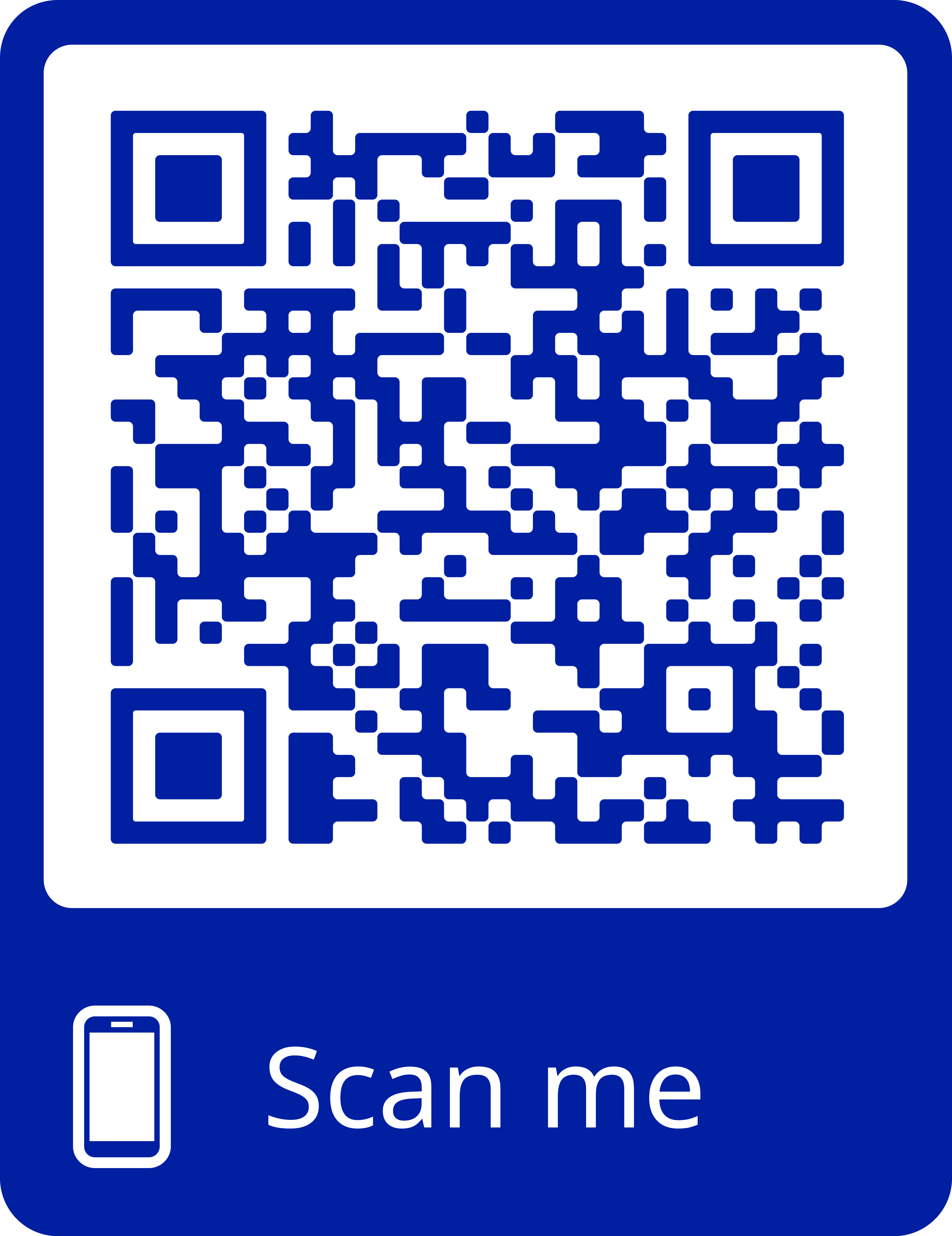- Reference Number: HEY1142/2023
- Departments: Rehabilitation Medicine
- Last Updated: 29 September 2023
Welcome to Complex Rehabilitation in Ward C1
You have been given this leaflet as you, or someone you know, has been admitted to Ward C1, Castle Hill Hospital for specialist rehabilitation. This leaflet aims to help you understand about Ward C1, what complex rehabilitation is, its purpose and what happens when you stay here.
Ward C1 is dedicated to specialist rehabilitation. Ward C1 admits a variety of people, from Hull and the East Riding of Yorkshire, who have varying clinical conditions with complex rehabilitation needs requiring a multidisciplinary team (MDT) approach. Some of the conditions we treat include those with a traumatic brain injury, neurological disorders, effects of deconditioning due to complex illness and other major types of trauma.
What facilities are available?
The Ward is equipped with many state of the art therapeutic facilities. All patients have a bed space and bathroom, which is either private or shared with one other patient. These spaces are big enough to accommodate supportive equipment and staff directing rehabilitation in all areas of rehabilitation that are important to individual patients. There is also a therapies gym area that patients will attend for treatment where possible. The ward also houses a fully equipped therapeutic kitchen and bathroom in the independent living space; here therapy staff will work with patients to regain activities for daily living, promoting their independence. Additionally, we have a day room, sensory room and secure garden area where patients can spend time resting, engaging in meaningful activities of enjoyment, and talking between themselves and staff.
Our Aims
On Ward C1 we aim to provide rehabilitation for patients with specialist needs in order to assist them to achieve their maximum quality of living through recovery of physical, cognitive, social and psychological function and participation in society.
We hope to achieve these aims within the limits of the clinical condition, facilities, equipment and personnel available to the service.
The aims will be achieved through the following processes:
Provision of MDT assessment based on clinical considerations
- Delivery of MDT therapy input and rehabilitative environment
- Goal setting, assessment, review and appraisal
- Ongoing medical review and input
- Supporting safe transition from hospital to discharge and liaising with other agencies to plan any long-term needs
Points to remember:
The goal of rehabilitation is to help patients be independent — to do as much for themselves as they are able to.
- Rehabilitation is done with a patient, not to a patient. The patient should be willing and able to work with the team during active treatment.
- Rehabilitation will not end when the patient leaves this ward. Rehabilitation is on-going and dynamic as the person’s abilities and needs change.
What is Specialist Rehabilitation?
“Rehabilitation involves working in partnership with you and those important to you so that they can maximise their potential and independence … It is a philosophy of care that helps to ensure people are included in their communities, employment and education” (NHS England Improving Rehabilitation Services, 2016).
Rehabilitation is a step-by-step process of assessment, treatment and management which may be difficult at times, but is one a patient helps guide. Putting the patient at the centre is fundamental to help ensure their rehabilitation is an active and enabling process. This involves taking into consideration what the patient would like to achieve and what is important to them, not just their physical and mental health.
Ward C1 will help a patient increase their independence and functional skills after injury or illness and aims to support patients to return to as much of their previous ability as possible. Where it is not possible for the patient to return to their previous functional abilities, the rehabilitation process will support the patient to explore new ways of doing things.
Specialist-Rehabilitation may include:
- Physical support to help increase movement, endurance and strength
- Help with mobility, using aids and wheelchairs
- Support with communication and swallowing difficulties
- Support with mental health and emotional difficulties
- Understanding cognition strengths and support needs
- Pain management
- Engaging in activities of daily living and creating a routine
- Learning new ways to look after yourself with an injury or disabilities
- Support and guidance in returning to work, family activities and leisure
- Support arranging home care services, where applicable
Your Rehabilitation Team
Whilst on Ward C1 you will be cared for by a MDT for rehabilitation, led by Consultants in Rehabilitation Medicine. Whilst you are in hospital, you may expect medical treatment to stabilise your physical condition, nursing care to aid this recovery and help you with some daily tasks.
Other members of the MDT, such as Occupational Therapists, Physiotherapists, Psychologists and Speech & Language Therapists, may ask to work with you to support your rehabilitation, helping you to engage in activities of daily living.
Depending on your injury and rehabilitation needs, you may not see all the listed professionals included within the MDT, below are some ideas about how they help in the rehabilitation process.
Who are we and what do we do?
Ward Clerk
 Often the first smile you’ll see on the ward. The Ward Clerk helps with the general day to day running of the ward such as answering phone calls and the organisation and scheduling of appointments off the ward. They will often direct visitors and are often responsible for the medical record keeping.
Often the first smile you’ll see on the ward. The Ward Clerk helps with the general day to day running of the ward such as answering phone calls and the organisation and scheduling of appointments off the ward. They will often direct visitors and are often responsible for the medical record keeping.
Doctors (Consultants, Specialist Doctor, Physician Associates)
 The medical team specialise in clinical medicine,
The medical team specialise in clinical medicine,
they guide clinical decisions, diagnose and treat specific
illnesses and health issues related to their field of expertise.
They often wear their own clothing or medical scrubs.
Nursing Team
Nurses provide round the clock care. Every shift you will be allocated nurses who are responsible for overseeing your care, led by a Registered Nurse. They offer support with day to day living if needed and will also dispense medications when required.
Sister (female) and Charge Nurse (male)
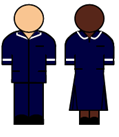 These nurses are in charge of their department.
These nurses are in charge of their department.
They wear navy uniform with white piping.
Staff Nurse/Senior Staff Nurse
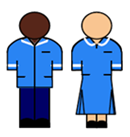 Registered Nurses make up the main body of staff. They wear light blue uniform with white piping.
Registered Nurses make up the main body of staff. They wear light blue uniform with white piping.
Auxiliary Nurses and CSW
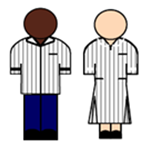 Auxiliary Nurses and Clinical Support Workers (CSW’s) assist Registered Nurses in many aspects of care. They wear white with navy stripes and white piping. CSWs have navy piping.
Auxiliary Nurses and Clinical Support Workers (CSW’s) assist Registered Nurses in many aspects of care. They wear white with navy stripes and white piping. CSWs have navy piping.
Student Nurse
 A Student Nurse wears a white tunic with navy tabs on the shoulder and navy trousers.
A Student Nurse wears a white tunic with navy tabs on the shoulder and navy trousers.
![]() 1 Stripe = First Year Students
1 Stripe = First Year Students
![]() 2 Stripe = Second Year
2 Stripe = Second Year
![]() 3 Stripes = Third Year
3 Stripes = Third Year
Rehabilitation Therapy Staff
Physiotherapy
 The purpose of physiotherapy is to help patients achieve their maximum physical potential. An initial assessment is carried out by a qualified member of staff and a treatment program is developed based on the patient’s goals. Treatment may be carried out by a qualified Physiotherapist, Exercise Practitioner and Therapy Assistant. Exercises may be provided for patients to carry out on their own between therapy sessions. Physiotherapy treatments can take place on the ward or in the Therapy Treatment Room. They wear navy scrubs, often with “Physiotherapy” on them.
The purpose of physiotherapy is to help patients achieve their maximum physical potential. An initial assessment is carried out by a qualified member of staff and a treatment program is developed based on the patient’s goals. Treatment may be carried out by a qualified Physiotherapist, Exercise Practitioner and Therapy Assistant. Exercises may be provided for patients to carry out on their own between therapy sessions. Physiotherapy treatments can take place on the ward or in the Therapy Treatment Room. They wear navy scrubs, often with “Physiotherapy” on them.
Occupational Therapy
 Occupational therapy will assess how your injury or illness has affected your ability to complete day-to-day tasks, considering both your cognitive and physical difficulties. Your therapy will use daily tasks such as showering, eating, meal preparation, shopping, cleaning and leisure activities, to enable you to return to doing things you need to do and enjoy. If you require a wheelchair or supportive seating, we will provide one to meet your needs. We may need to assess your home environment, issue equipment and make recommendation for adaptations in order to improve your independence and quality of life for discharge. They also wear a set of navy scrubs, often with “Occupational Therapy” on them.
Occupational therapy will assess how your injury or illness has affected your ability to complete day-to-day tasks, considering both your cognitive and physical difficulties. Your therapy will use daily tasks such as showering, eating, meal preparation, shopping, cleaning and leisure activities, to enable you to return to doing things you need to do and enjoy. If you require a wheelchair or supportive seating, we will provide one to meet your needs. We may need to assess your home environment, issue equipment and make recommendation for adaptations in order to improve your independence and quality of life for discharge. They also wear a set of navy scrubs, often with “Occupational Therapy” on them.
Clinical Psychology
 There is also a Clinical Psychologist available. Psychologists support patients who have experienced emotional, behavioural or cognitive difficulties as a result of changes to their health. By its nature, being in hospital can be frightening. People lives have often changed a lot and talking to a Psychologist can help you to understand these changes and maintain good well-being in order to best benefit from rehabilitation. They may also be involved in cognitive assessments for patients who have sustained brain injury as well as helping patients learn new techniques to manage any identified difficulties. Psychologists often wear their own clothing or grey scrubs.
There is also a Clinical Psychologist available. Psychologists support patients who have experienced emotional, behavioural or cognitive difficulties as a result of changes to their health. By its nature, being in hospital can be frightening. People lives have often changed a lot and talking to a Psychologist can help you to understand these changes and maintain good well-being in order to best benefit from rehabilitation. They may also be involved in cognitive assessments for patients who have sustained brain injury as well as helping patients learn new techniques to manage any identified difficulties. Psychologists often wear their own clothing or grey scrubs.
Speech and Language Therapy
 Speech and Language Therapists work with individuals whose speech, language; swallowing and eating may be affected. They help inform the Rehabilitation Team and family about communication methods and work with the individual to develop verbal and non-verbal strategies of communication if needed. They wear navy scrubs, often with “Speech & Language Therapy” on them.
Speech and Language Therapists work with individuals whose speech, language; swallowing and eating may be affected. They help inform the Rehabilitation Team and family about communication methods and work with the individual to develop verbal and non-verbal strategies of communication if needed. They wear navy scrubs, often with “Speech & Language Therapy” on them.
Dietician
 If required, the Dietitian will assess your nutritional needs to provide the most appropriate route of nutrition support e.g. oral intake, tube feeding or intravenous feeding. In addition, the Dietician may prescribe oral nutritional supplements or tailored feeding regimens which help to meet your nutritional requirements. They wear navy scrubs, often with “Dietitian” on them.”
If required, the Dietitian will assess your nutritional needs to provide the most appropriate route of nutrition support e.g. oral intake, tube feeding or intravenous feeding. In addition, the Dietician may prescribe oral nutritional supplements or tailored feeding regimens which help to meet your nutritional requirements. They wear navy scrubs, often with “Dietitian” on them.”
House Keeper
 The Housekeeper supports the ward in some organisational and recreational activities. They wear a burgundy top with navy trousers.
The Housekeeper supports the ward in some organisational and recreational activities. They wear a burgundy top with navy trousers.
Domestic Staff
 The Domestic Staff’s role is to ensure the ward is sanitary, tidy and fit for use. they help to provide a clean, comfortable environment. They wear a purple top and black trousers.
The Domestic Staff’s role is to ensure the ward is sanitary, tidy and fit for use. they help to provide a clean, comfortable environment. They wear a purple top and black trousers.
Catering Team
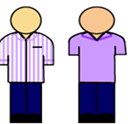 The Catering Team prepare and deliver food. They will ask you what you would like to eat and drink. They wear a purple polo or white shirt with purple stripes and navy trousers.
The Catering Team prepare and deliver food. They will ask you what you would like to eat and drink. They wear a purple polo or white shirt with purple stripes and navy trousers.
Team Communication
Patients on Ward C1 are cared for by an MDT. Communication between the different team members is essential and will be carried out constantly and consistently, with patients at the centre. Below are a few of the meetings which take place that enable the team to effectively plan your treatment.
Ward Rounds
These are medical reviews and are conducted by the Medical Team, often involving a Consultant in Rehabilitation Medicine. They focus on the physical aspects of your care and usually take place on a Wednesday. They are also an opportunity for the patient to engage and ask any questions you may have for the medical staff. There is also daily medical ward cover provided by Junior and Middle Grade Medical personnel (doctors) and by our Physician Associate.
Multi-Disciplinary Team (MDT) meetings
MDT meetings take place on a Thursday and involves a variety of specialities who come together to discuss your care, progress and treatment plan. This tends to be for the professionals involved in the patient’s care. However patients can always ask for something to be brought to MDT to be discussed by the wider team.
Goal setting meetings (GSM)
We have goal setting meetings for each patient on the ward, to establish what they want to achieve from their rehabilitation experience. The first goal-setting meeting usually happens after an initial two-week assessment period. These meetings aim to establish what the patient’s realistic long-term goal is and what their short-term goals will enable them to work towards this. The patient and/or family will be given a copy of the goals agreed to after the meeting. Staff will guide you on deciding on your goals but want these to be personal and meaningful to the patient. There will usually be a member of staff representing each discipline actively involved in the patient’s care who will talk about their work with them and feedback about their treatment so far. These meetings will be repeated regularly throughout admission to track progress and review therapeutic goals towards discharge. Patients are encouraged to invite members of their family, in case they have any questions for the team.
Discharge planning meetings (DPM)
Although discharge will be spoken about from the beginning of your stay on Ward C1, these meetings aim to specifically focus on factors that will be involved in your discharge and follow a similar pattern to goal setting meetings.
Rehabilitation Routine
All staff will wear appropriate Person Protective Equipment (PPE) for all patient contact to reduce the risk of infection which is removed and replaced between each patient.
06:00 – 08:00: Waking up and getting ready for the day. Patients will be encouraged to wash and dress themselves and join in with their personal cares wherever possible. However, if required the Nursing Team will also help you to prepare for the day. Occupational therapy may also provide support to work on personal care by engaging in showering and dressing.
08:00 – 09:00: Breakfast – if required patients will be supported to eat meals throughout the day, dependent upon needs. There are medication rounds at different times throughout the day where nursing staff will provide patients with their prescribed medication.
09:00 – 12:00: Individual rehabilitative therapy sessions may take place during this time. This is dependent on therapy goals and assessments. Between these times, patients may also wish to take part in some recreational activities.
12:00 – 13:00: Lunch is served. This is a protected mealtime on the ward where no clinical activities take place, other than in an emergency. This is to ensure patients are comfortable and have no interruptions, allowing them to meet their nutritional needs to support rehabilitation.
13:00 – 17:00: Individual rehabilitative therapy sessions may also take place during this time if required. Therapies will be discontinued after 17:00 and will start again in the morning. Again, patients also may wish to take part in some recreational activities. We also encourage patients to access outside areas if feasible as this can support wellbeing. There is a courtyard which is regularly accessible.
17:00-18:00: Evening meal is served. The catering staff will also offer patients a menu so that they can determine what food you would like for the rest of the day/following day. This is also a protected mealtime.
18:00: This is the patient’s own personal time, which you can utilise as you would like to. Sleep is an essential part of recovery and rehabilitation and patients are encouraged to try to build a good sleeping pattern. Patients will be helped to get ready for bed at whatever time they choose. Some patients may also require assistance to reposition through the night in order to manage pressure areas and maintain good skin integrity.
Why is it important to have this structure?
Patients on Ward C1 are undergoing an intensive recovery from serious injury or change in health condition. This process of rehabilitation can be very exhausting, and many patients have suffered a brain injury or significant illness, causing further fatigue. The ward needs to manage the level of stimulation and activity each patient is exposed to, protecting the rehabilitative environment; ensuring patients are able to engage in their rehabilitation in order to support patients to gain their best therapeutic outcomes. Patients will likely have individualised care plans to manage their needs, but having a structured environment around them can also support recovery.
Practical Considerations
Personal belongings
Lengths of stay on Ward C1 can vary; we recommend bringing enough day and nightwear, toiletries and footwear for 7 days and arrange regular laundry with family/carers.
- Recommended toiletries include shampoo, conditioner, soap, shower gel, deodorant and any creams you may need.
- Recommended clothes include comfortable bottoms (e.g. joggers), T-shirts, jumpers and underwear, as well as sensible indoor and outdoor shoes.
- There are cupboards in each patient bed-space to store some personal belongings.
- The ward cannot be responsible for personal belongings and recommend items of value remain or are returned home.
Telephones and Tablets/IPads: Patients own mobile phones or tablets are allowed on the ward, however some patients may find using them confusing, over-stimulating and fatiguing. This may therefore be managed clinically to support rehabilitation. Please be aware that taking photographs of other patients is not permitted; but you may take photographs of staff and facilities so long as you have sought permission. People are asked to remain respectful in how they use their mobile phones.
Electrical items: In accordance with safe practice, our electrician must check all electrical items brought into hospital. Please liaise with the nurse in charge so that this can be arranged to minimise inconvenience for you. This will include mobile chargers, laptop computers and their accessories.
Ward Access
A coded door is used on the unit. This enables staff to monitor the safety of those patients who would be at risk if they were to leave the unit unsupervised. Please alert staff if you wish to leave the ward.
Visitors
The Ward encourages visitors once a patient is able to receive them. Currently, visiting hours are 4pm to 8pm on weekdays, and 2pm to 8pm on weekends. All visitors are welcome, from friends and family, and we can occasionally accommodate visits from pets.
- For some patients, it may be medically necessary to regulate the number of visitors. If this is the case, it will be discussed with you. The trust rules dictate that there should only be 2 patients to a bed for infection control purposes.
- Visiting times do not include meal times as they are protected. For patients who require assistance or support to eat, family are encouraged to provide this support as clinically appropriate and if they would like to. Please just discuss this with the care team.
Ward Address
Some people may wish to send personal items to patients currently admitted, such as snacks, home comforts or entertainment. Please check with the ward that these are appropriate before sending. The full address and postcode is: Complex Rehabilitation Ward C1, Entrance 2, Castle Hill Hospital, Castle Road, Cottingham, East Yorkshire, HU16 5JQ.
Preparing for Discharge
- Discharge planning will begin from the point of admission to Ward C1 and is a continuous process as well as a key focus rehabilitation planning. We will work with the patient and their family/carer to help us create a safe discharge from hospital. Once a discharge date has been agreed between the patient, their care team, and if appropriate their family/carer, the ward staff will arrange everything needed such as medication, transport, outpatient appointment and in some circumstances equipment to help facilitate a safe discharge home.
- Occasionally staff may need to attend a person’s home in order to assess its suitability for discharge and any need for equipment.
- The MDT will work closely with the patient and their family/carer to ensure a safe discharge to a suitable setting, whether this is the patient’s home or a more appropriate care setting. This may also include making referrals for any specialist equipment to help you move around safely in your home, referrals for adaptations to the home, as well as any care support that may be needed.
- Prior to discharge, weekend or day leave may be appropriate in order to help ease the transition and ensure the environment is suitable.
- Following discharge patients may have on-going needs, if so an onward referral for Community Therapy to continue rehabilitation will be made as appropriate. This will be at the most appropriate location for your needs and requirements. Discharge from Ward C1 is not the end of rehabilitation.
This leaflet has been produced by the Hull University Teaching Hospitals NHS Trust and is available as a download:
Download the “Introduction to the Complex Rehabilitation Inpatient Ward 1, CHH” leaflet
